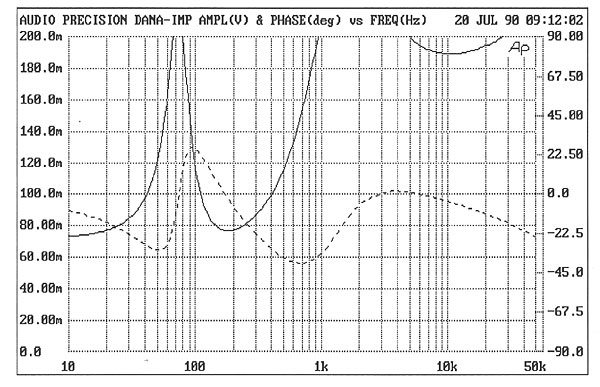| Columns Retired Columns & Blogs |
what's the point of putting out these super old reviews ?.......just to make up the numbers eh......
I began the measurements with the Listening Environment Diagnostic Recording (LEDR) described by Bob Katz in Vol.12 No.12 and found on the Chesky Jazz Sampler CD. The LEDR test consists of a sampled cabasa (a percussion instrument) that has had its sound manipulated by a computer to give the illusion of the instrument moving in three-dimensional space. Three tests comprise LEDR: in "Up," the sound should appear to move up in a straight line from the loudspeaker; the "Over" test is also called the "rainbow" since the image should follow a rainbow-shaped arc above the two loudspeakers; and the "Lateral" test should produce an image that moves in an unbroken straight line from one loudspeaker to the other. The LEDR test reveals a loudspeaker's ability to throw an image, provided the listening room itself doesn't destroy the imaging.
The Dana Model 1s did fairly well on the "Up" test, but with the image stopping below the point heard through the Hales Signatures. The "Over" test was better, but with some discontinuities in the image. The "Lateral" was fairly good, the Model 1s producing a stable image between the loudspeakers.
I drove the Model 1s with a variable-frequency sinewave oscillator, with my hand on the cabinet to detect resonances. Surprisingly, the 1s exhibited no major cabinet resonances. Instead, there were many low-Q resonances throughout the entire low-frequency band. The highest-amplitude resonance was at 170Hz, when there was a buzzing sound from the cabinet.
The Model 1's impedance magnitude and phase are shown in fig.1. The overall impedance is quite high, dropping near the 8 ohm specification below about 40Hz and again at 200Hz. In addition, the phase angle is minimal throughout the midrange and treble. The Model 1 should thus be an easy load to drive. The sealed-box woofer tuning is revealed by the narrow impedance peak centered on 73Hz.

Looking at the time domain, fig.2 shows the anechoic portion of the Model 1's impulse response taken at 48" on the tweeter axis. I was able to get a fairly long anechoic "window" by placing the Model 1s on stacked Celestion stands, which, coupled with my listening room's high ceiling, pushed the first reflections more than 5ms away from the loudspeaker's direct response. (The frequency resolution of these FFT tests is proportional to the time window before the first reflection of the pulse, normally that from the floor, arrives at the microphone position. 5ms' worth of anechoic impulse response corresponds, therefore, to 200Hz resolution.) The jaggedness after the initial pulse is most likely the result of a tweeter resonance.

Fig.3 shows the Model 1's FFT-derived frequency response averaged over a 30° lateral window. A nearfield measurement of the woofer, taken with the microphone capsule almost touching the dustcap, has been appended to the left-hand side of the spatially averaged frequency response, revealing a –6dB point at 58Hz, correlating with the 73Hz woofer tuning. The woofer's rolloff is 12dB/octave, as expected from the sealed-box alignment. The midrange is remarkably smooth up to about 4kHz, while the overall lower level of treble energy apparent in the plot correlates with my impression of the Model 1's somewhat depressed treble balance. Unfortunately, the large peak in the response falls just above 4kHz, a region where the ear is quite sensitive to amplitude irregularities. Although the region between 1kHz and 4kHz is somewhat lower than that between 100Hz and 1kHz, the "forward" midrange character I noted is most likely the result of this peak.

Looking at how the FFT-derived frequency response changes over time after the stimulus has been removed (fig.4), the Model 1's decay characteristics are quite good. The treble decays cleanly and rapidly. However, there is a severe ridge visible at 4.5kHz, the energy at this frequency taking a long time to decay. (The small dark ridge near 16kHz is the computer monitor's scanning frequency, not part of the loudspeaker's behavior.) The titanium-coated tweeter's primary resonance is apparent at about 28kHz.

Overall, the Dana Model 1 measured very well for such an inexpensive product.—Robert Harley

what's the point of putting out these super old reviews ?.......just to make up the numbers eh......

what's the point of putting out these super old reviews ?
To judge from the page views, there are other people who are not you who do enjoy reading these vintage reviews. You can always not read them if they bother you.
John Atkinson
Editor, Stereophile

I bought this wonderful speakers by reading the review in Stereophile, when I studied in the US almost three decades ago. I also bought the
Vandy 2CE and quite a few of hi-fi equipments which were recommended by Stereophile before I came back to my home country.
Recently, I just came back to Hi-Fi. I can assure that my Dana speakers, not in 100% shape, still hold its own against my recently acquired Wharfedale Diamond 10.1. Both are very good speakers, but still not as good as Elac B5 and B6 (I bought both even before Stereophile reviewed the B6. I think B5 is almost as good as B6. They are almost identical, however, B6 seems easier to drive, maybe because of higher sensitivity.)
All in all, I still enjoy listening music with my Dana Audio model 1.

That you should take care of the front end and associated electronics if you want a proper sound system. My loudspeakers cost me $650 new, coming up next year to their 20th anniversary. In the meantime, I have upgraded from a NAD receiver (bought at a pawn shop for $250) to some nice electronics, a REGA RP3 with some judicious upgrades and a DENON 103, and fine electronics in between. My system's MSRP comes out at something like $8000 ... although I bought many items used ... but those speakers are still there, and everything sounds very, very nice, thank you.